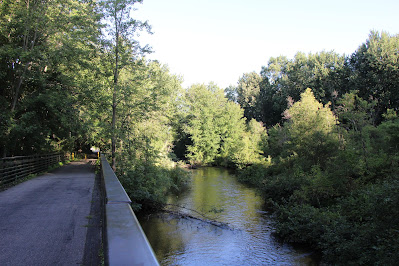It’s early morning. The air is still and chilly with temperatures in the low 50’s. Under sunny skies, I begin hiking through the 14-acre Stearns Preserve, making my way past white blossoms of Queen Anne’s Lace and yellow blossoms of Canadian Goldenrod toward the Pine River. After pausing on the lush bank to watch the water flow slowly past, I glance down at the muddy shore to see a couple of ½-inch resting Water striders. The legs of these insects have tiny hairs that repel water and capture air. By repelling water, they stand on the water’s surface and the captured airs allows them to float and move easily. Proceeding along the bank through dense vegetation, I first approach red blossoms of a Cardinal flower and then stop to observe white blossoms of Queen Anne’s Lace where some are folding into nest-like cups. Looking more closely at one of them, I notice a ¼ inch Carrot Seed Moth Caterpillar encased in a web. Eventually it will pupate within the webbing and emerge as an adult moth (stock photo). Moving up unto the Meijer Bike trail, I head east and pause on a high bridge to observe the Pine River flow gently south through a corridor of green florae. Descending to the water’s edge, I spot dozens of Whirligig beetles (stock photo) gathering and swarming midstream, using a motion called “flash expansion” to escape predators. Back on the bike trail, white blossoms of Wild Cucumber and blue blossoms of Lobelia catch my eye. Turning around and heading west toward the car, I notice red berries of Maple leaf Viburnum and blue berries of Virginia Creeper. Creeper berries contain tiny needle-shaped crystals that are so small they cannot be seen without a microscope. If chewed by humans, these crystals can poke the tongue, mouth and throat, causing irritation, drooling, and redness. On the other hand, these berries are eaten by a host of animals, including birds, mice, skunks, squirrels and deer. Approaching the car, I examine a patch of Milkweed where I spot a Milkweed Bug resting on a leaf. This insect is often confused with a Boxelder bug because they are similar in size and share some colors, but their patterns differ (stock photo). On another Milkweed plant, I observe a bristly 1-½ inch Milkweed Tussocks Moth Caterpillar. The hairs on these caterpillars can cause a very itchy rash, especially in children who are more likely to be playing and handling them. These fascinating caterpillars feed all day long on milkweed plants and store ingested toxic cardiac glycosides in their bodies to make them repulsive to predator, such as birds. After pupation they emerge as adult moths (stock photo).
Pair of fawns
Mother deer
Rhythm of life
Beating clear
Meadow thistle
Showing seed
Finches of gold
Perch and feed
Cycle of nature
Continues to flow
Days of summer
Come and go
D. DeGraaf



